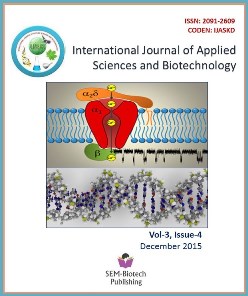Resource Use Efficiency of Mustard Production in Chitwan District of Nepal
DOI:
https://doi.org/10.3126/ijasbt.v3i4.13525Keywords:
Allocative efficiency, Cobb-Douglas production function, pollinator, profitability, return to scaleAbstract
The study was conducted to determine the profitability and resource use efficiency of mustard production in Chitwan. The study used 159 mustard growers from 300 farmers adopting different pollinator friendly practices. Descriptive and statistical tools including Cobb-Douglas production function were used to analyze data which were collected from structured interview schedule. The benefit cost ratio (1.43) indicates that mustard production was profitable with productivity of 0.81 ton per ha. The magnitude of regression coefficients of mustard implied that use of human labor, tractor, nutrient and irrigation and pesticides costs had significant positive effect on gross return with estimated increasing return to scale (1.03). According to estimated allocative efficiency indices, it is suggested to increase use of tractor labor, seed, nutrient and irrigation plus pesticides cost by about 47%, 82%, 84% and 94%, respectively. Extension of modern technologies with adjustment on resource use is to be encouraged for increase in productivity and profit from mustard production which indirectly promotes and ensure forage for pollinators.
Int J Appl Sci Biotechnol, Vol 3(4): 604-608
Downloads
1636
1073




